ICT120: Network Upgrade Report for Credit Crunch Company
VerifiedAdded on 2022/10/01
|10
|2035
|204
Report
AI Summary
This report details a network upgrade plan for Credit Crunch (CC), a debt recovery service. The report addresses the need for a network overhaul, focusing on the migration from IPv4 to IPv6 due to security concerns and address exhaustion, and proposes a structured cabling plan using GPON for increased bandwidth. It also suggests a star-like network topology and an IP addressing scheme, along with the implementation of a PBX phone system to replace the current VoIP system. The report recommends adopting IPv6, implementing the GPON plan for scalability and cost reduction, and transitioning to a PBX phone system to reduce call costs. The analysis includes justifications for the proposed solutions, network topology diagrams, and IP addressing schemes. Overall, the report provides a comprehensive overview of the network upgrade process and its benefits for CC.

INTRODUCTION TO COMPUTER NETWORKS 1
ICT120: INTRODUCTION TO COMPUTER NETWORKS TASK 2
By (Student Name)
(Course Name)
(Tutor’s Name)
(Date)
ICT120: INTRODUCTION TO COMPUTER NETWORKS TASK 2
By (Student Name)
(Course Name)
(Tutor’s Name)
(Date)
Paraphrase This Document
Need a fresh take? Get an instant paraphrase of this document with our AI Paraphraser

INTRODUCTION TO COMPUTER NETWORKS 2
Executive summary
Credit Crunch is an organization that operates debt recovery service for banks and other
financial institutions. For the last ten years. The organization requires an upgrade of its system.
The organization is located in Sydney for its head office, and staff. The organization operates
predictive Dialler software that is connected to telephony board which makes calls to debtors
and debtor database software which is a client/server DBMS. This report will highlight how CC
will go about in upgrading its network.
Executive summary
Credit Crunch is an organization that operates debt recovery service for banks and other
financial institutions. For the last ten years. The organization requires an upgrade of its system.
The organization is located in Sydney for its head office, and staff. The organization operates
predictive Dialler software that is connected to telephony board which makes calls to debtors
and debtor database software which is a client/server DBMS. This report will highlight how CC
will go about in upgrading its network.

INTRODUCTION TO COMPUTER NETWORKS 3
Table of Contents
Executive summary..........................................................................................................................2
Table of Figures................................................................................................................................4
1.0 Introduction...............................................................................................................................5
2.0 Network upgrade.......................................................................................................................5
2.1 Structured Cabling plan..........................................................................................................6
2.1.0 Justification of GPON plan...............................................................................................6
2.2. Network topology diagram...................................................................................................6
2.3 IP addressing..........................................................................................................................7
3.0 Addition site, VoIP or redundant Servers..................................................................................7
Table of Contents
Executive summary..........................................................................................................................2
Table of Figures................................................................................................................................4
1.0 Introduction...............................................................................................................................5
2.0 Network upgrade.......................................................................................................................5
2.1 Structured Cabling plan..........................................................................................................6
2.1.0 Justification of GPON plan...............................................................................................6
2.2. Network topology diagram...................................................................................................6
2.3 IP addressing..........................................................................................................................7
3.0 Addition site, VoIP or redundant Servers..................................................................................7
⊘ This is a preview!⊘
Do you want full access?
Subscribe today to unlock all pages.

Trusted by 1+ million students worldwide

INTRODUCTION TO COMPUTER NETWORKS 4
Table of Figures
Figure 1: GPON plan.........................................................................................................................4
Figure 2: Proposed network topology.............................................................................................5
Figure 3: PBX IP phone system........................................................................................................6
Table of Figures
Figure 1: GPON plan.........................................................................................................................4
Figure 2: Proposed network topology.............................................................................................5
Figure 3: PBX IP phone system........................................................................................................6
Paraphrase This Document
Need a fresh take? Get an instant paraphrase of this document with our AI Paraphraser
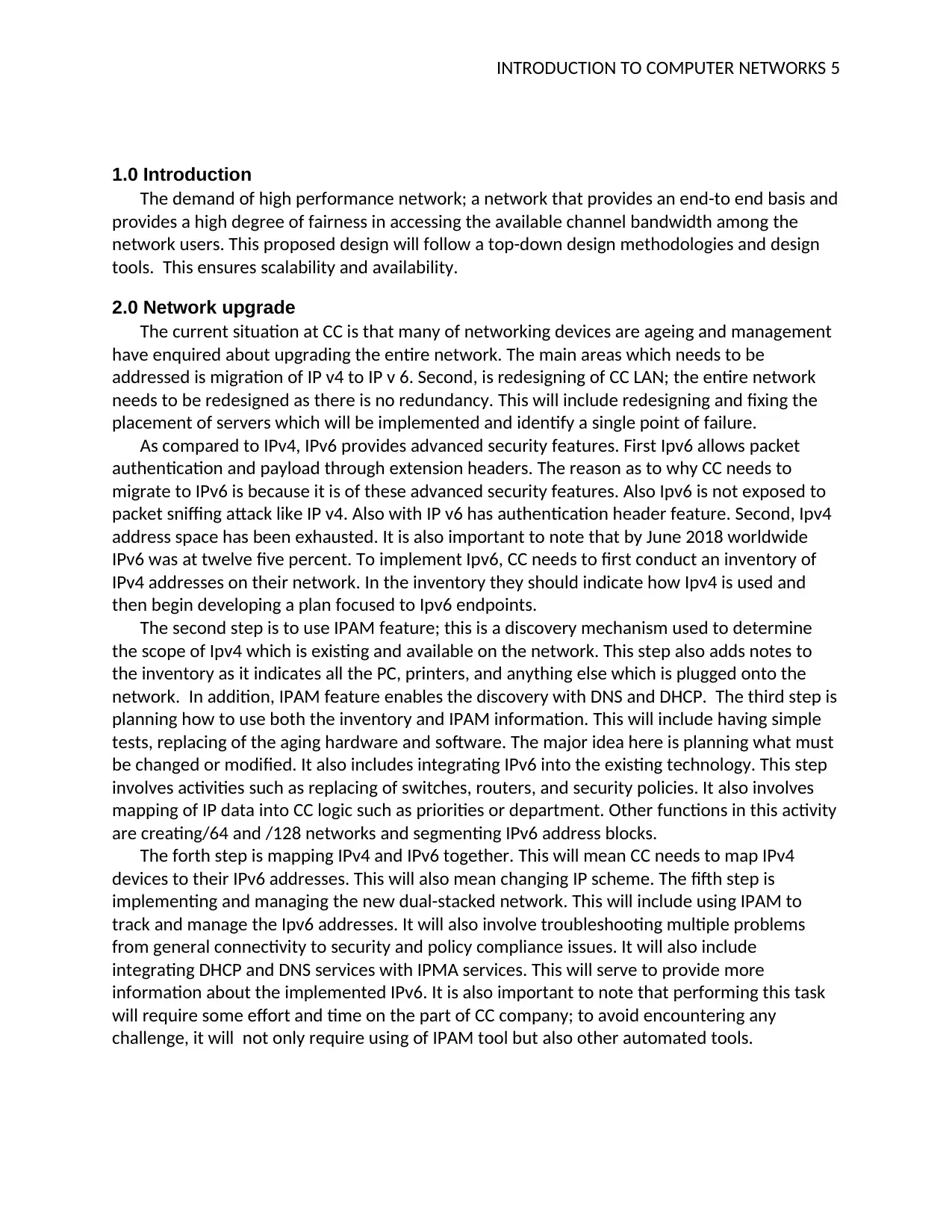
INTRODUCTION TO COMPUTER NETWORKS 5
1.0 Introduction
The demand of high performance network; a network that provides an end-to end basis and
provides a high degree of fairness in accessing the available channel bandwidth among the
network users. This proposed design will follow a top-down design methodologies and design
tools. This ensures scalability and availability.
2.0 Network upgrade
The current situation at CC is that many of networking devices are ageing and management
have enquired about upgrading the entire network. The main areas which needs to be
addressed is migration of IP v4 to IP v 6. Second, is redesigning of CC LAN; the entire network
needs to be redesigned as there is no redundancy. This will include redesigning and fixing the
placement of servers which will be implemented and identify a single point of failure.
As compared to IPv4, IPv6 provides advanced security features. First Ipv6 allows packet
authentication and payload through extension headers. The reason as to why CC needs to
migrate to IPv6 is because it is of these advanced security features. Also Ipv6 is not exposed to
packet sniffing attack like IP v4. Also with IP v6 has authentication header feature. Second, Ipv4
address space has been exhausted. It is also important to note that by June 2018 worldwide
IPv6 was at twelve five percent. To implement Ipv6, CC needs to first conduct an inventory of
IPv4 addresses on their network. In the inventory they should indicate how Ipv4 is used and
then begin developing a plan focused to Ipv6 endpoints.
The second step is to use IPAM feature; this is a discovery mechanism used to determine
the scope of Ipv4 which is existing and available on the network. This step also adds notes to
the inventory as it indicates all the PC, printers, and anything else which is plugged onto the
network. In addition, IPAM feature enables the discovery with DNS and DHCP. The third step is
planning how to use both the inventory and IPAM information. This will include having simple
tests, replacing of the aging hardware and software. The major idea here is planning what must
be changed or modified. It also includes integrating IPv6 into the existing technology. This step
involves activities such as replacing of switches, routers, and security policies. It also involves
mapping of IP data into CC logic such as priorities or department. Other functions in this activity
are creating/64 and /128 networks and segmenting IPv6 address blocks.
The forth step is mapping IPv4 and IPv6 together. This will mean CC needs to map IPv4
devices to their IPv6 addresses. This will also mean changing IP scheme. The fifth step is
implementing and managing the new dual-stacked network. This will include using IPAM to
track and manage the Ipv6 addresses. It will also involve troubleshooting multiple problems
from general connectivity to security and policy compliance issues. It will also include
integrating DHCP and DNS services with IPMA services. This will serve to provide more
information about the implemented IPv6. It is also important to note that performing this task
will require some effort and time on the part of CC company; to avoid encountering any
challenge, it will not only require using of IPAM tool but also other automated tools.
1.0 Introduction
The demand of high performance network; a network that provides an end-to end basis and
provides a high degree of fairness in accessing the available channel bandwidth among the
network users. This proposed design will follow a top-down design methodologies and design
tools. This ensures scalability and availability.
2.0 Network upgrade
The current situation at CC is that many of networking devices are ageing and management
have enquired about upgrading the entire network. The main areas which needs to be
addressed is migration of IP v4 to IP v 6. Second, is redesigning of CC LAN; the entire network
needs to be redesigned as there is no redundancy. This will include redesigning and fixing the
placement of servers which will be implemented and identify a single point of failure.
As compared to IPv4, IPv6 provides advanced security features. First Ipv6 allows packet
authentication and payload through extension headers. The reason as to why CC needs to
migrate to IPv6 is because it is of these advanced security features. Also Ipv6 is not exposed to
packet sniffing attack like IP v4. Also with IP v6 has authentication header feature. Second, Ipv4
address space has been exhausted. It is also important to note that by June 2018 worldwide
IPv6 was at twelve five percent. To implement Ipv6, CC needs to first conduct an inventory of
IPv4 addresses on their network. In the inventory they should indicate how Ipv4 is used and
then begin developing a plan focused to Ipv6 endpoints.
The second step is to use IPAM feature; this is a discovery mechanism used to determine
the scope of Ipv4 which is existing and available on the network. This step also adds notes to
the inventory as it indicates all the PC, printers, and anything else which is plugged onto the
network. In addition, IPAM feature enables the discovery with DNS and DHCP. The third step is
planning how to use both the inventory and IPAM information. This will include having simple
tests, replacing of the aging hardware and software. The major idea here is planning what must
be changed or modified. It also includes integrating IPv6 into the existing technology. This step
involves activities such as replacing of switches, routers, and security policies. It also involves
mapping of IP data into CC logic such as priorities or department. Other functions in this activity
are creating/64 and /128 networks and segmenting IPv6 address blocks.
The forth step is mapping IPv4 and IPv6 together. This will mean CC needs to map IPv4
devices to their IPv6 addresses. This will also mean changing IP scheme. The fifth step is
implementing and managing the new dual-stacked network. This will include using IPAM to
track and manage the Ipv6 addresses. It will also involve troubleshooting multiple problems
from general connectivity to security and policy compliance issues. It will also include
integrating DHCP and DNS services with IPMA services. This will serve to provide more
information about the implemented IPv6. It is also important to note that performing this task
will require some effort and time on the part of CC company; to avoid encountering any
challenge, it will not only require using of IPAM tool but also other automated tools.
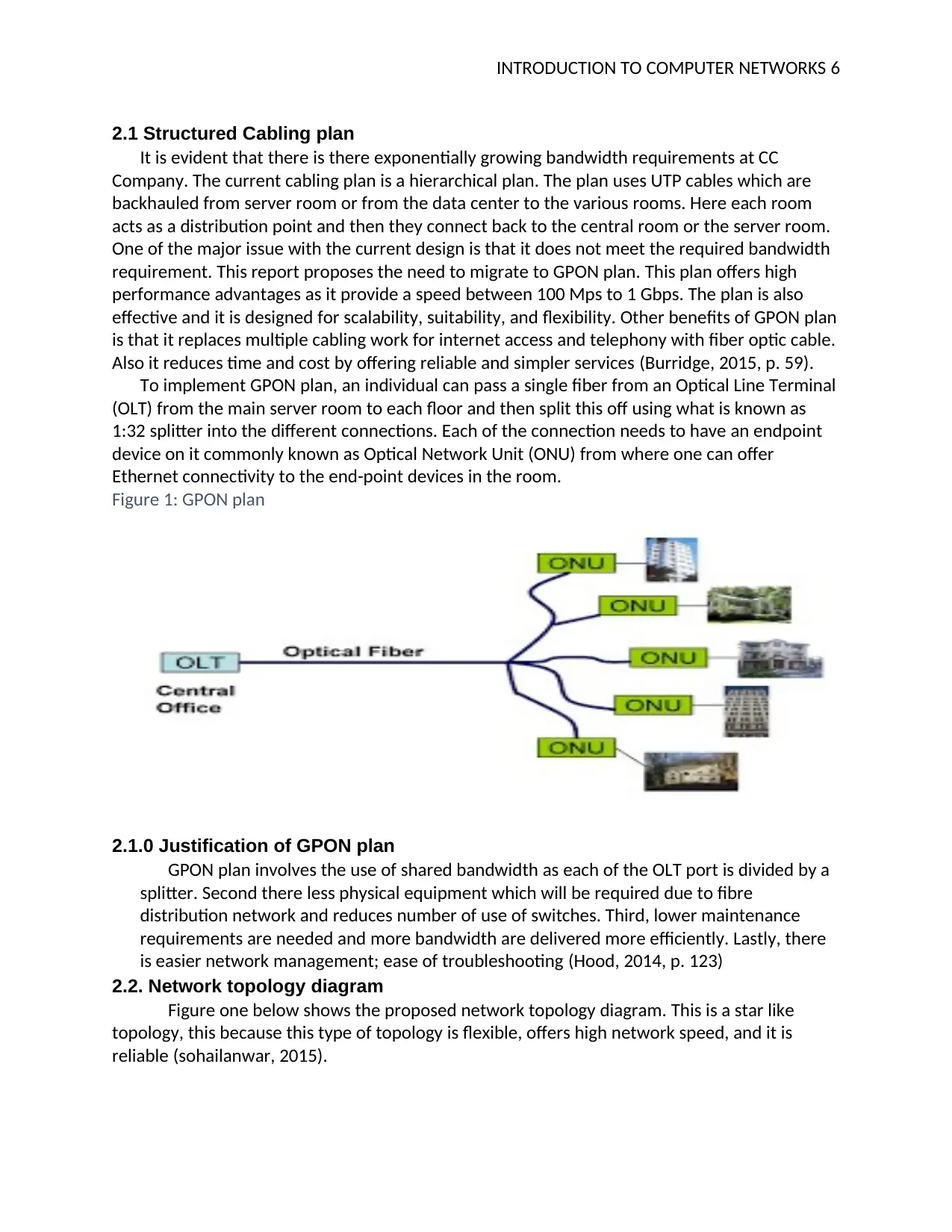
INTRODUCTION TO COMPUTER NETWORKS 6
2.1 Structured Cabling plan
It is evident that there is there exponentially growing bandwidth requirements at CC
Company. The current cabling plan is a hierarchical plan. The plan uses UTP cables which are
backhauled from server room or from the data center to the various rooms. Here each room
acts as a distribution point and then they connect back to the central room or the server room.
One of the major issue with the current design is that it does not meet the required bandwidth
requirement. This report proposes the need to migrate to GPON plan. This plan offers high
performance advantages as it provide a speed between 100 Mps to 1 Gbps. The plan is also
effective and it is designed for scalability, suitability, and flexibility. Other benefits of GPON plan
is that it replaces multiple cabling work for internet access and telephony with fiber optic cable.
Also it reduces time and cost by offering reliable and simpler services (Burridge, 2015, p. 59).
To implement GPON plan, an individual can pass a single fiber from an Optical Line Terminal
(OLT) from the main server room to each floor and then split this off using what is known as
1:32 splitter into the different connections. Each of the connection needs to have an endpoint
device on it commonly known as Optical Network Unit (ONU) from where one can offer
Ethernet connectivity to the end-point devices in the room.
Figure 1: GPON plan
2.1.0 Justification of GPON plan
GPON plan involves the use of shared bandwidth as each of the OLT port is divided by a
splitter. Second there less physical equipment which will be required due to fibre
distribution network and reduces number of use of switches. Third, lower maintenance
requirements are needed and more bandwidth are delivered more efficiently. Lastly, there
is easier network management; ease of troubleshooting (Hood, 2014, p. 123)
2.2. Network topology diagram
Figure one below shows the proposed network topology diagram. This is a star like
topology, this because this type of topology is flexible, offers high network speed, and it is
reliable (sohailanwar, 2015).
2.1 Structured Cabling plan
It is evident that there is there exponentially growing bandwidth requirements at CC
Company. The current cabling plan is a hierarchical plan. The plan uses UTP cables which are
backhauled from server room or from the data center to the various rooms. Here each room
acts as a distribution point and then they connect back to the central room or the server room.
One of the major issue with the current design is that it does not meet the required bandwidth
requirement. This report proposes the need to migrate to GPON plan. This plan offers high
performance advantages as it provide a speed between 100 Mps to 1 Gbps. The plan is also
effective and it is designed for scalability, suitability, and flexibility. Other benefits of GPON plan
is that it replaces multiple cabling work for internet access and telephony with fiber optic cable.
Also it reduces time and cost by offering reliable and simpler services (Burridge, 2015, p. 59).
To implement GPON plan, an individual can pass a single fiber from an Optical Line Terminal
(OLT) from the main server room to each floor and then split this off using what is known as
1:32 splitter into the different connections. Each of the connection needs to have an endpoint
device on it commonly known as Optical Network Unit (ONU) from where one can offer
Ethernet connectivity to the end-point devices in the room.
Figure 1: GPON plan
2.1.0 Justification of GPON plan
GPON plan involves the use of shared bandwidth as each of the OLT port is divided by a
splitter. Second there less physical equipment which will be required due to fibre
distribution network and reduces number of use of switches. Third, lower maintenance
requirements are needed and more bandwidth are delivered more efficiently. Lastly, there
is easier network management; ease of troubleshooting (Hood, 2014, p. 123)
2.2. Network topology diagram
Figure one below shows the proposed network topology diagram. This is a star like
topology, this because this type of topology is flexible, offers high network speed, and it is
reliable (sohailanwar, 2015).
⊘ This is a preview!⊘
Do you want full access?
Subscribe today to unlock all pages.

Trusted by 1+ million students worldwide
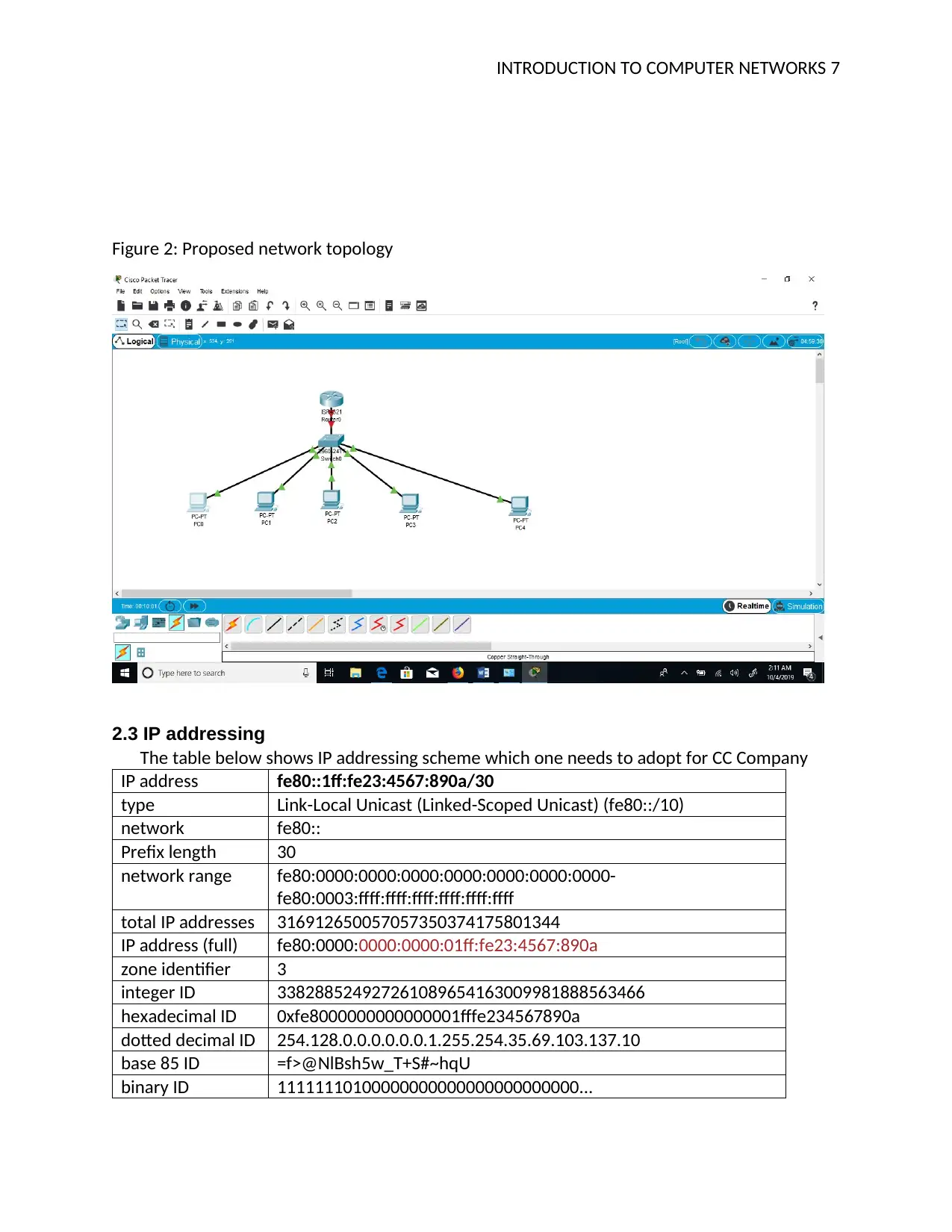
INTRODUCTION TO COMPUTER NETWORKS 7
Figure 2: Proposed network topology
2.3 IP addressing
The table below shows IP addressing scheme which one needs to adopt for CC Company
IP address fe80::1ff:fe23:4567:890a/30
type Link-Local Unicast (Linked-Scoped Unicast) (fe80::/10)
network fe80::
Prefix length 30
network range fe80:0000:0000:0000:0000:0000:0000:0000-
fe80:0003:ffff:ffff:ffff:ffff:ffff:ffff
total IP addresses 316912650057057350374175801344
IP address (full) fe80:0000:0000:0000:01ff:fe23:4567:890a
zone identifier 3
integer ID 338288524927261089654163009981888563466
hexadecimal ID 0xfe8000000000000001fffe234567890a
dotted decimal ID 254.128.0.0.0.0.0.0.1.255.254.35.69.103.137.10
base 85 ID =f>@NlBsh5w_T+S#~hqU
binary ID 11111110100000000000000000000000...
Figure 2: Proposed network topology
2.3 IP addressing
The table below shows IP addressing scheme which one needs to adopt for CC Company
IP address fe80::1ff:fe23:4567:890a/30
type Link-Local Unicast (Linked-Scoped Unicast) (fe80::/10)
network fe80::
Prefix length 30
network range fe80:0000:0000:0000:0000:0000:0000:0000-
fe80:0003:ffff:ffff:ffff:ffff:ffff:ffff
total IP addresses 316912650057057350374175801344
IP address (full) fe80:0000:0000:0000:01ff:fe23:4567:890a
zone identifier 3
integer ID 338288524927261089654163009981888563466
hexadecimal ID 0xfe8000000000000001fffe234567890a
dotted decimal ID 254.128.0.0.0.0.0.0.1.255.254.35.69.103.137.10
base 85 ID =f>@NlBsh5w_T+S#~hqU
binary ID 11111110100000000000000000000000...
Paraphrase This Document
Need a fresh take? Get an instant paraphrase of this document with our AI Paraphraser
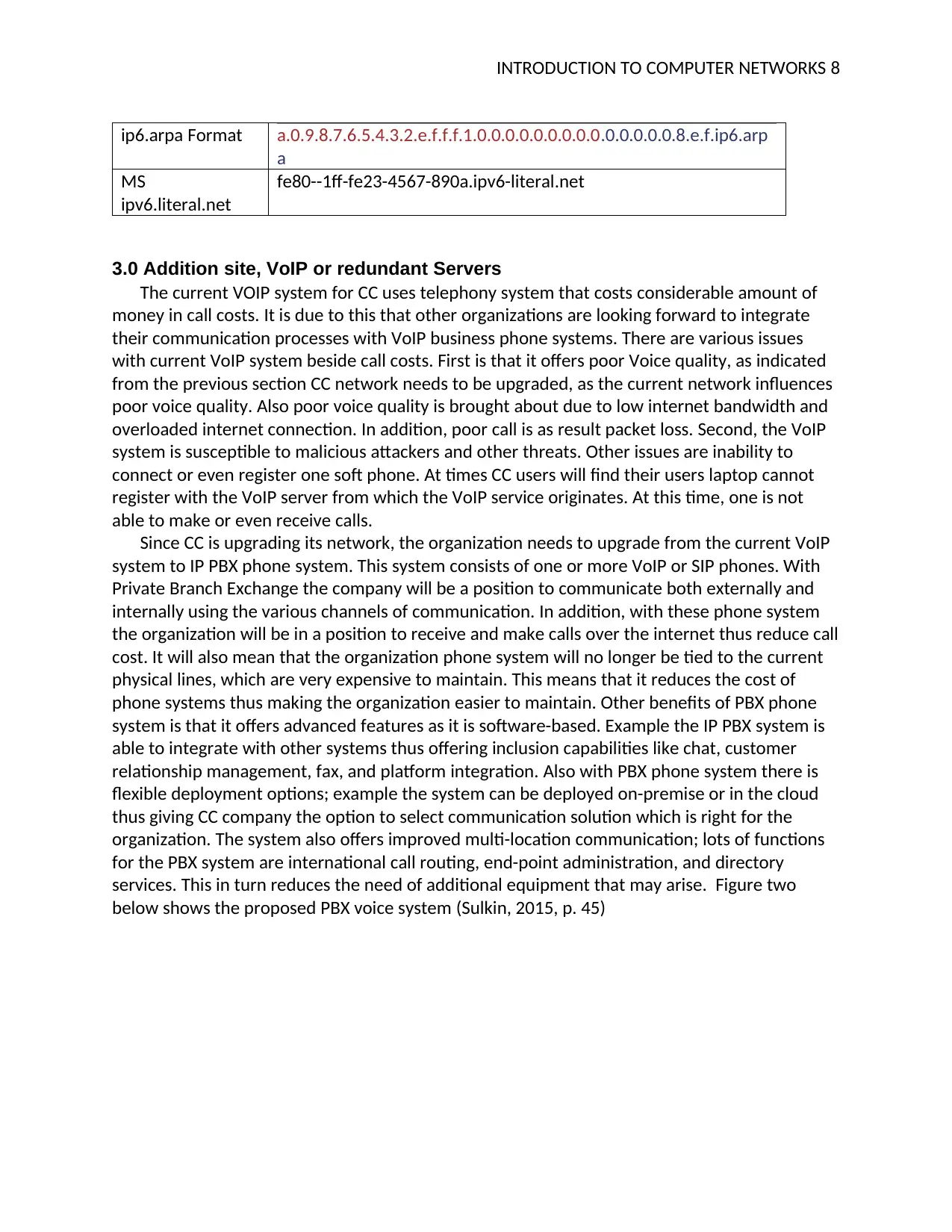
INTRODUCTION TO COMPUTER NETWORKS 8
ip6.arpa Format a.0.9.8.7.6.5.4.3.2.e.f.f.f.1.0.0.0.0.0.0.0.0.0.0.0.0.0.0.8.e.f.ip6.arp
a
MS
ipv6.literal.net
fe80--1ff-fe23-4567-890a.ipv6-literal.net
3.0 Addition site, VoIP or redundant Servers
The current VOIP system for CC uses telephony system that costs considerable amount of
money in call costs. It is due to this that other organizations are looking forward to integrate
their communication processes with VoIP business phone systems. There are various issues
with current VoIP system beside call costs. First is that it offers poor Voice quality, as indicated
from the previous section CC network needs to be upgraded, as the current network influences
poor voice quality. Also poor voice quality is brought about due to low internet bandwidth and
overloaded internet connection. In addition, poor call is as result packet loss. Second, the VoIP
system is susceptible to malicious attackers and other threats. Other issues are inability to
connect or even register one soft phone. At times CC users will find their users laptop cannot
register with the VoIP server from which the VoIP service originates. At this time, one is not
able to make or even receive calls.
Since CC is upgrading its network, the organization needs to upgrade from the current VoIP
system to IP PBX phone system. This system consists of one or more VoIP or SIP phones. With
Private Branch Exchange the company will be a position to communicate both externally and
internally using the various channels of communication. In addition, with these phone system
the organization will be in a position to receive and make calls over the internet thus reduce call
cost. It will also mean that the organization phone system will no longer be tied to the current
physical lines, which are very expensive to maintain. This means that it reduces the cost of
phone systems thus making the organization easier to maintain. Other benefits of PBX phone
system is that it offers advanced features as it is software-based. Example the IP PBX system is
able to integrate with other systems thus offering inclusion capabilities like chat, customer
relationship management, fax, and platform integration. Also with PBX phone system there is
flexible deployment options; example the system can be deployed on-premise or in the cloud
thus giving CC company the option to select communication solution which is right for the
organization. The system also offers improved multi-location communication; lots of functions
for the PBX system are international call routing, end-point administration, and directory
services. This in turn reduces the need of additional equipment that may arise. Figure two
below shows the proposed PBX voice system (Sulkin, 2015, p. 45)
ip6.arpa Format a.0.9.8.7.6.5.4.3.2.e.f.f.f.1.0.0.0.0.0.0.0.0.0.0.0.0.0.0.8.e.f.ip6.arp
a
MS
ipv6.literal.net
fe80--1ff-fe23-4567-890a.ipv6-literal.net
3.0 Addition site, VoIP or redundant Servers
The current VOIP system for CC uses telephony system that costs considerable amount of
money in call costs. It is due to this that other organizations are looking forward to integrate
their communication processes with VoIP business phone systems. There are various issues
with current VoIP system beside call costs. First is that it offers poor Voice quality, as indicated
from the previous section CC network needs to be upgraded, as the current network influences
poor voice quality. Also poor voice quality is brought about due to low internet bandwidth and
overloaded internet connection. In addition, poor call is as result packet loss. Second, the VoIP
system is susceptible to malicious attackers and other threats. Other issues are inability to
connect or even register one soft phone. At times CC users will find their users laptop cannot
register with the VoIP server from which the VoIP service originates. At this time, one is not
able to make or even receive calls.
Since CC is upgrading its network, the organization needs to upgrade from the current VoIP
system to IP PBX phone system. This system consists of one or more VoIP or SIP phones. With
Private Branch Exchange the company will be a position to communicate both externally and
internally using the various channels of communication. In addition, with these phone system
the organization will be in a position to receive and make calls over the internet thus reduce call
cost. It will also mean that the organization phone system will no longer be tied to the current
physical lines, which are very expensive to maintain. This means that it reduces the cost of
phone systems thus making the organization easier to maintain. Other benefits of PBX phone
system is that it offers advanced features as it is software-based. Example the IP PBX system is
able to integrate with other systems thus offering inclusion capabilities like chat, customer
relationship management, fax, and platform integration. Also with PBX phone system there is
flexible deployment options; example the system can be deployed on-premise or in the cloud
thus giving CC company the option to select communication solution which is right for the
organization. The system also offers improved multi-location communication; lots of functions
for the PBX system are international call routing, end-point administration, and directory
services. This in turn reduces the need of additional equipment that may arise. Figure two
below shows the proposed PBX voice system (Sulkin, 2015, p. 45)
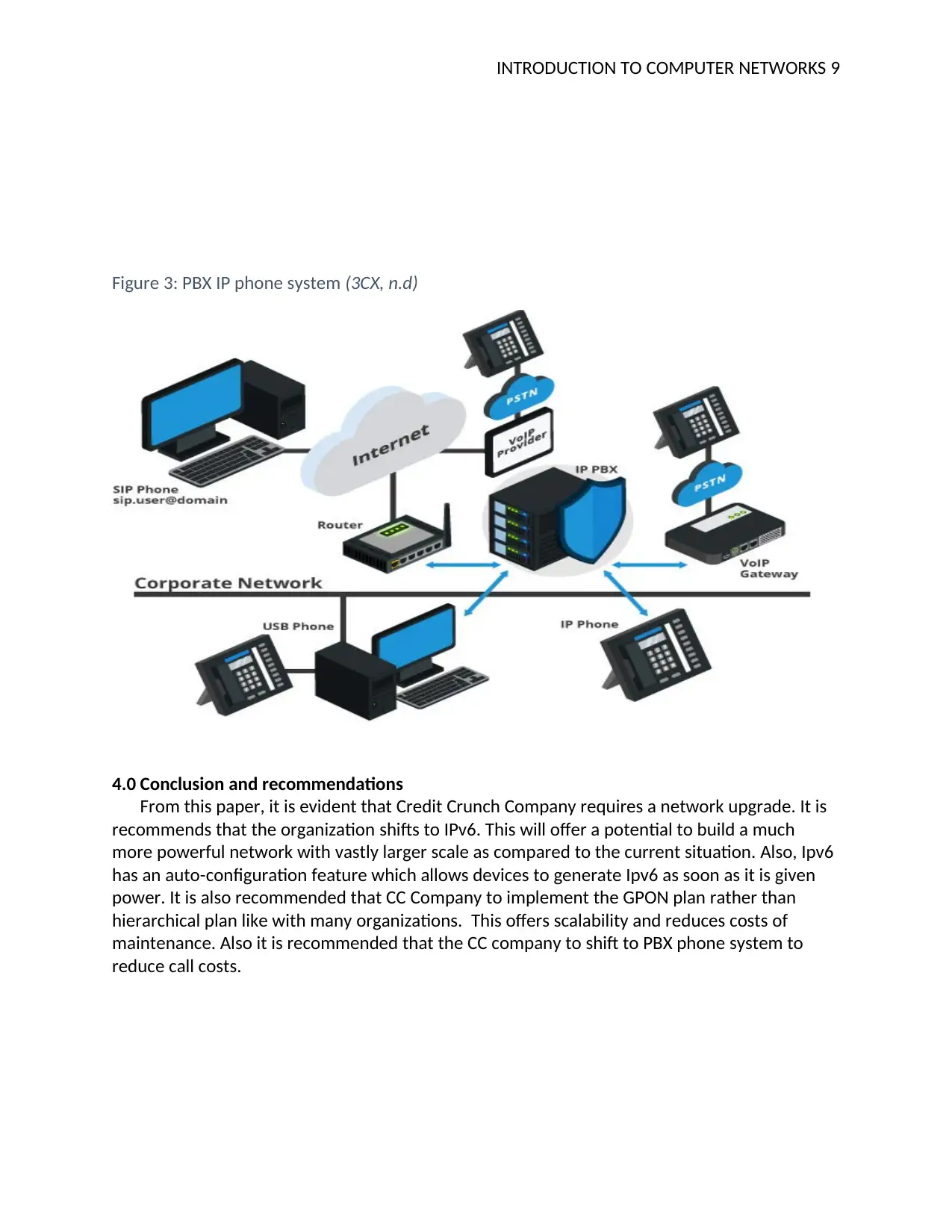
INTRODUCTION TO COMPUTER NETWORKS 9
Figure 3: PBX IP phone system (3CX, n.d)
4.0 Conclusion and recommendations
From this paper, it is evident that Credit Crunch Company requires a network upgrade. It is
recommends that the organization shifts to IPv6. This will offer a potential to build a much
more powerful network with vastly larger scale as compared to the current situation. Also, Ipv6
has an auto-configuration feature which allows devices to generate Ipv6 as soon as it is given
power. It is also recommended that CC Company to implement the GPON plan rather than
hierarchical plan like with many organizations. This offers scalability and reduces costs of
maintenance. Also it is recommended that the CC company to shift to PBX phone system to
reduce call costs.
Figure 3: PBX IP phone system (3CX, n.d)
4.0 Conclusion and recommendations
From this paper, it is evident that Credit Crunch Company requires a network upgrade. It is
recommends that the organization shifts to IPv6. This will offer a potential to build a much
more powerful network with vastly larger scale as compared to the current situation. Also, Ipv6
has an auto-configuration feature which allows devices to generate Ipv6 as soon as it is given
power. It is also recommended that CC Company to implement the GPON plan rather than
hierarchical plan like with many organizations. This offers scalability and reduces costs of
maintenance. Also it is recommended that the CC company to shift to PBX phone system to
reduce call costs.
⊘ This is a preview!⊘
Do you want full access?
Subscribe today to unlock all pages.

Trusted by 1+ million students worldwide
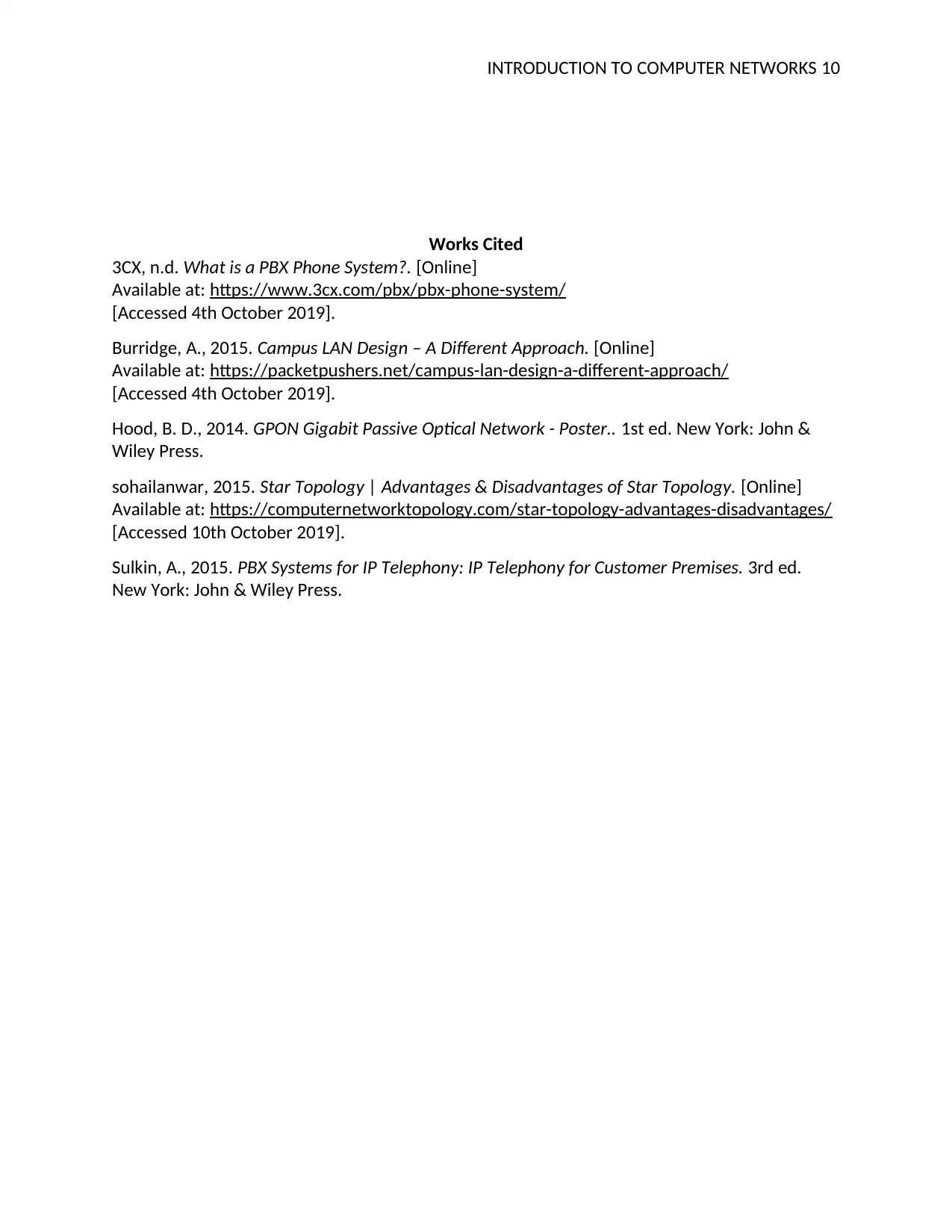
INTRODUCTION TO COMPUTER NETWORKS 10
Works Cited
3CX, n.d. What is a PBX Phone System?. [Online]
Available at: https://www.3cx.com/pbx/pbx-phone-system/
[Accessed 4th October 2019].
Burridge, A., 2015. Campus LAN Design – A Different Approach. [Online]
Available at: https://packetpushers.net/campus-lan-design-a-different-approach/
[Accessed 4th October 2019].
Hood, B. D., 2014. GPON Gigabit Passive Optical Network - Poster.. 1st ed. New York: John &
Wiley Press.
sohailanwar, 2015. Star Topology | Advantages & Disadvantages of Star Topology. [Online]
Available at: https://computernetworktopology.com/star-topology-advantages-disadvantages/
[Accessed 10th October 2019].
Sulkin, A., 2015. PBX Systems for IP Telephony: IP Telephony for Customer Premises. 3rd ed.
New York: John & Wiley Press.
Works Cited
3CX, n.d. What is a PBX Phone System?. [Online]
Available at: https://www.3cx.com/pbx/pbx-phone-system/
[Accessed 4th October 2019].
Burridge, A., 2015. Campus LAN Design – A Different Approach. [Online]
Available at: https://packetpushers.net/campus-lan-design-a-different-approach/
[Accessed 4th October 2019].
Hood, B. D., 2014. GPON Gigabit Passive Optical Network - Poster.. 1st ed. New York: John &
Wiley Press.
sohailanwar, 2015. Star Topology | Advantages & Disadvantages of Star Topology. [Online]
Available at: https://computernetworktopology.com/star-topology-advantages-disadvantages/
[Accessed 10th October 2019].
Sulkin, A., 2015. PBX Systems for IP Telephony: IP Telephony for Customer Premises. 3rd ed.
New York: John & Wiley Press.
1 out of 10
Your All-in-One AI-Powered Toolkit for Academic Success.
+13062052269
info@desklib.com
Available 24*7 on WhatsApp / Email
![[object Object]](/_next/static/media/star-bottom.7253800d.svg)
Unlock your academic potential
Copyright © 2020–2025 A2Z Services. All Rights Reserved. Developed and managed by ZUCOL.